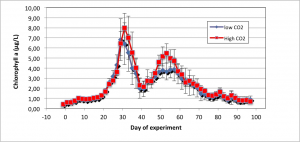For more than 13 weeks now the plankton communities enclosed in our ten mesocosms live their own lives. They don’t know of each other and have no idea of what’s going on in the sea surrounding them. Yet, they all seem to follow the same pattern of species succession, of biomass build-up and decline.
Think of all the factors that could make them wander off in completely different directions. Small differences in the composition of the seed populations at the start of the experiment could magnify into vastly different communities as time progresses. Small disparities in the abundance and composition of predators in our mesocosms could have large cascading effects on the entire food web. I have now doubt those differences existed when we closed the mesocosms and still exist now, that the phyto- and zooplankton communities have gone through multiple generations. Surprisingly, they have not resulted in each mesocosm’s orchestra playing it’s own song. Instead they all seem to play the same symphony, with slightly different interpretations.

Concentration of chlorophyll a, an indicator of phytoplankton biomass: it shows the same rhythm in all mesocosms (measured by Matthias Fischer and Andrea Ludwig)
But who is conducting the symphony? What makes all 10 plankton orchestras play the same rhythm, even after nearly 100 days in separate concert halls? The truth is, we don’t know. But it is good news for our long-term mesocosm study. It means that the five mesocosms for each CO2 treatment can still serve as replicates, even for such a long experiment. And it means that the unique long-term data set resulting from this study allows us to examine the impacts of ocean acidification on a natural plankton community that has developed, acclimated and possibly adapted to the new conditions over many generations. This makes us optimistic that – once the full data set becomes available – it will give us fundamentally new insights into the sensitivities of marine life to ocean acidification.
By Ulf Riebesell